RFinder B1 Review
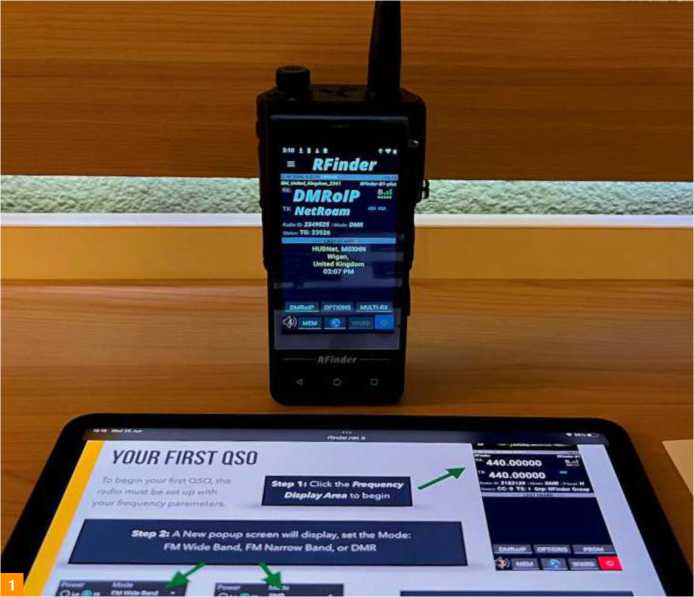
Joe Chester gets excited by the RFinder B1, to the extent that he actually buys one!
So, I pull around a corner, and I hear what was a very strange conversation. A Scotsman is trying to teach an American to speak English like a Scotsman. “Only use o’s and u’s”, he says. “So, I koop a hord of abordun ongus cuttle”, which the American repeats back very convincingly, even more so when they start on some less savoury language. Although what on earth started this conversation, I have no idea. I decided to risk life and limb, so I interrupted. “Is that it”, I managed, my eyes popping open. The ‘it’ is a whole new ballgame, as the Americans say. Now don’t run away in search of the DX page, hear me out. Read our RFinder B1 Review.

Fig. 1: Your first QSO.
It’s a radio, a V/UHF handheld one, 4 watts out. It’s built like a brick, and waterproof to IP67. What sets it apart on first sight is the full-size screen. Like on a smartphone. Oops, I shouldn’t have said that right away. Because it is. Yes, it’s also a smartphone. But I’m getting ahead. The Scotsman is Graham 2M0IGV, and the Americans, for there are two of them, are Bob W2CYK and his buddy Joe, straight out of college. Graham is waving one around in his hand, so I make a grab for it, and ask him to show me what it can do. “It’s six years old, and still works a dream”, he says. Bob says that it’s gone through six generations since the first version, which Graham is rather proud of. One push, enter a few numbers, and voice emanates from the thing. Big beams all around. Like any kid handling a piece of advanced technology, this looks like magic, so I reach out to check that Graham doesn’t also have a pair of pigeons, and a magic wand up his sleeve!
The next trick is down to Bob. “Look at the display”, he says. “That repeater wasn’t there yesterday, it was set up here last night, for the show”, as he presses an icon on the screen and toggles the PTT. And back comes a voice in reply. OK, time for a bit of an explanation I think.
So,What’s it About?
I’m at the Friedrichshafen show, towards the end of my second day there. I missed Bob and Joe the previous day, as their stand is basically a wall with three posters behind two chairs and a table. An international crowd has now gathered, and the conversation is buzzing. “How did you get the frequencies and tone information for the repeater”, someone asks, in perfectly broken English. “That’s the magic”, says Graham. You see Bob has a database. It contains all the frequencies and access tones for every repeater in the world. And it’s updated from primary sources every night. You’ve no doubt heard of it. It’s called the RFINDER WW Database. Bob has been selling subscriptions to access this database for some years now. Then he got the
idea to manufacture a V/UHF handheld that would take the information in this database and automatically set up the frequencies in the radio. But rather than start with an actual existing radio and try to modify its operating system (an impossible task), he got the notion of programming a fairly obvious and easily available operating system – Android, on a smartphone. Brilliant! But it gets even better.
What Bob did was to manufacture his own smartphones, and during manufacture to put an RF chip in them! Now, using software he and his team wrote, when the thing is powered up, you just select the repeater you want to operate, push an icon on the screen, and then the PTT, and away you go. And it works very, very well. But I promised you more. As it’s basically a computer, it can be programmed so that it can send and receive DMR signals as well, over the Brandmeister network of servers.
Now, you will recall the piece I did on digital radio some time back. I bought a cheap digital/ analogue handheld, the Retevis RT3S, and got it working. But to do this, I needed to download software from the manufacturer’s site, and create and modify the radio’s settings – the codeplug. You have to understand that these digital radios use standards developed by ETSI for commercial users. We amateur operators have to be able to do as the suppliers of these radios do for their commercial customers. And there are those who understand the processes involved very well, and who are very helpful to the rest of us to get the right codeplug into these sets. Then, there are the rest of us.
The Joys of RFinder
But RFINDER has made all this effort rather redundant. Because the radio has access to the RFINDER DMR database too. This means that after setting up, and logging into the Brandmeister system, there are no more codeplugs needed. Ever. And I proved this in a hotel room in Dijon, 250 miles south of Paris, two days after I picked up my RFINDER radio. I powered it up, connected to WiFi (who ever heard of a V/UHF analogue radio needing a WiFi connection? But let’s carry on), checked for updates, signed into Google (it’s an Android phone after all!), and entered my DMR ID and Brandmeister password. It powers up connected to the RFINDER Talk Group, so I pressed the TG icon, and a numeric screen appeared. I entered 23276, the UK Hubnet Talk Group, and pressed the set icon. A few minutes later I heard QSOs on-going on Hubnet. When these were finished,
I pushed the PTT and sent my callsign. I was answered by Garry MM6ZGS in Airdrie. His audio stream to me was perfect, but he said that there were losses on my signal to him. This is a well-known problem with IP transport; it’s called packet loss, and it’s something we all live with, even using our mobile phones (“sorry, could you repeat that, you’re breaking up?”).
But ten minutes later I heard Jan PA0MVP/M calling for a radio check. I answered him, and we had a nice conversation, with no disruption from packet loss. So, straight out of the box, after entering a few pieces of personal data, the RFinder B1 is making and receiving DMR calls, no codeplug needed!! And how cool is that, I can’t help but ask? And there’s more!
One of the interesting features uses Google maps – yes, it’s a smartphone! In RF mode, the handset uses the onboard GPS chip to find its location, and then interrogates the database for repeaters within 50 miles or so, and displays them on a map, or in a list if you prefer. Press the one you want to use, then SET, press the PTT and you get access to that repeater. And, at the risk of repetition, the database is updated daily. In fact, if you think about this (and I’m borrowing someone else’s line here), the RFINDER B1 is actually a new radio every day, reprogrammed with the current frequencies, and access tones for every repeater in the world. Plus, all the currently active DMR Talk Groups.
What’s in it?
Someone said something interesting at the end of my afternoon with Bob and Joe and Graham. Radio amateurs are not satisfied with using a piece of technology, but want to know in detail how the thing works. And how to hack it. Such as whether there might be other ways to upload the repeater database information? And what RF chip is it using? Or whether it could do D-STAR or Fusion. Honestly? “But surely not all of us”, I said. I could see the frustration on Bob’s face, because these questions and more were routinely being asked. It’s as if this level of performance just wasn’t good enough, and we want to see the magician saw the assistant in half as well.
There are more than enough easily accessed tools on this radio to keep even the most technically minded of us busy and happy for quite a while. For example, it’s a smartphone, so has a SIM card slot. Insert a cheap data SIM, and you don’t even need WiFi access anymore. How’s that for the ultimate in handheld radios? So, you’re up a mountain peak, RFINDER B1 in hand. Light up all the repeaters around you, and get on DMR as well! “Hello yes, I’m standing on top of (insert your favourite hill), looking at the lake in the valley
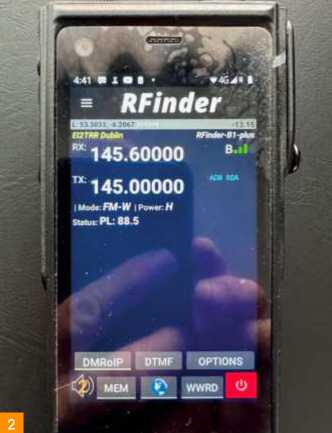
Fig. 2: My local repater.
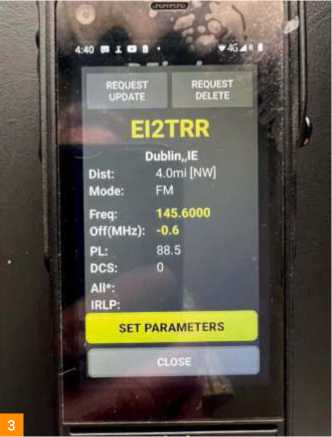
Fig. 3: Just push and set.
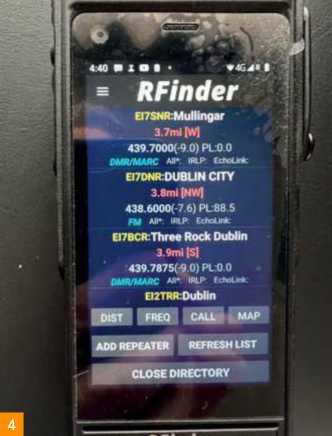
Fig. 4: List view.
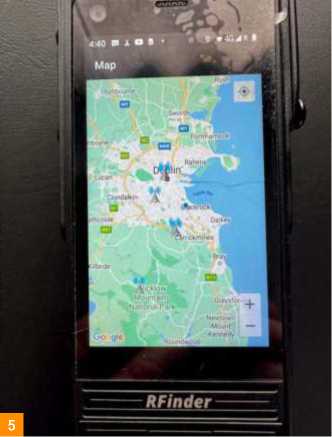
Fig. 5: Map view.
below, It’s a balmy -20° degrees and the snow is a brilliant white”. And using DMR over IP, or through any one of the repeaters the RFINDER can see and which has a digital gateway attached, and you are literally telling the world where you are and what you are doing.
TheTechnical Stuff
OK, you want the sawing in half trick. You want more technical stuff. It’s a 2m/70cm handheld transceiver. Is it better or worse than any others currently on the market? Its operating range is quite wide: 136 to 174MHz, and 400 to 490MHz. Well for ease of programming, it’s clearly better. Any repeater anywhere in the world at the push of a button. Audio is clean, 2 watts out through the onboard speaker, and my audio was reported similarly. There is a speaker/mic option, which uses a strange looking set of contacts on the side, but I can’t see any way to add an earphone or a Iapel mic. Oh, wait a minute, it’s an Android smartphone, with Bluetooth! I’m off to the shops
tomorrow for a Bluetooth earpiece/mic. I can’t see why that won’t work (see the note at the end of this piece). Is 4 watts RF output enough? Well, if it isn’t, you can always add an amplifier. But isn’t that the same for other handies, some with less output power than the RFINDER B1? Some reviewers have lamented the inability to scan through a list of repeaters to find activity. Yeah, that’s true, but a feature to scan memories is in work, and will come with a future software update. And there is a promiscuous mode on the DMR side that listens to every TG, so that partly compensates I suppose. Memories? Bob says that there is an almost infinite set of memories, which can be organised into Zones or whatever else you want to call them. A UK one, a France one, a USA one maybe, or a Local and Not Local Zone? Who cares what you call them as long as you know what they are. And since I mentioned software updates, then I suppose this makes the RFINDER B1 an SDR as well!
The 5in screen display is a good as on any
smartphone, but you are recommended to put a screen protector on it. I was given a free one, just for annoying Bob all afternoon! A nice to have, I think, is the little stub antenna Graham had on his. It just looks neater, and doesn’t seem to matter for local repeater access. High on my shopping list is the relevant adapter to PL259, so that I can attach it to my rail-mounted 2m/70cm whip in the car. Batteries? I’m glad you asked. When last did you see a smartphone with exchangeable externally mounted batteries? If you run out of power chatting to the world up that hill, just swap in a spare. There are options such as slim and big here, but any two should be enough. They say it should run all day with even the smallest of the battery options. It comes with a drop-in charger, so while you’re having fun with it with on one battery, the spare can be recharging in the charger. Or, and this is a new option on the RFINDER B1+ model (which is the one I have), just plug in a USB-C connection to recharge it. I haven’t checked if it will run with the USB-C plugged in, with no battery attached, but I think I heard someone say it would (again, note at the end). The only other thing to note is that the volume control on the top; it clicks into each setting, so it won’t accidentally get turned up or, worse, down.
And finally, when you are tired using it as I have described, recall that it’s a smartphone. So, download Zello, or any of the other ‘network radio’ apps doing the rounds. The RFINDER B1 has a second PTT switch, below the RF one, which can be assigned to these Apps.
Other Matters
You should note that a subscription to the RFINDER WW database is required if you want daily updates from the RFINDER website (about $ a year, or two cups of coffee!). Mine came with a 30-day free trial. Warranty is one year. But Bob is (if he will forgive me for revealing this) so committed to his brainchild, that I have read reports of him coming up on WhatsApp at unearthly hours to help iron out issues for his customers. And Graham’s earlier model still looked pristine after six years, despite being in regular use while herding Aberdeen Angus cattle around the place.
Oh yes, it’s not exactly inexpensive, currently at $ or so. But it’s a lot of technology for that price – smartphone plus V/UHF handheld, plus no codeplugs too! Is it a convincing idea? Definitely! Does it do everything it says it will do straight out of the box? Yes (after initialisation with some essential user data). Would I recommend it? Certainly, especially if like me, programming codeplugs is the closest thing to having teeth drilled without Novocaine. In fact, the way it does DMR is a bit more intuitive than playing with codeplugs. You are basically logging into the Brandmeister set of IP servers across the world, as you would with any computer network.
Now this will raise a philosophical question in the minds of many amateur radio operators. If you think about what I just said, then this device could and does enable worldwide QSOs without the intervention of amateur radio RF anywhere along the path between the operators. Of course, if you access the DMR system through a repeater, then this last does not apply, since your access to that repeater requires RF, for which you need to be a licensed amateur operator. An interesting speculation indeed.
And under the same heading (philosophy), then let me say that there are multiple ways to get on DMR. Some of these approaches use an Android smartphone, or a computer and some software. However, these solutions don’t include a V/UHF handheld radio option. So, if you add up the cost of getting set up on DMR and on V/UHF, then this will increase the total cost. Then there is the programming issue, be it entering repeater frequencies and tone access codes manually, or programming codeplugs. As in all walks of life, you can DIY a solution, or you can buy one ready and set to go.
But back to the RFINDER B1+. Any questions? OK hold that thought, Bob will be at Newark! I’ve told him that there are thousands of amateurs over here who hate codeplugs, and to bring supplies of his no-codeplug radio with him. The ten he had available in Friedrichshafen went in a day. I just about got the last one (and drove down across Switzerland to Milan to pick it up!). Oh, did I mention the belt clip? And the cameras (front and back)? And Bluetooth? Oh, of course, it’s a smartphone, so you can use it as a phone too! Regrets? Yeah, that Friedrichshafen came near the end of my six-week Grand Tour of Europe’s finest (Belgium, France, Switzerland, Austria, Germany, Italy, even Liechtenstein, this one for the first time!). Look at what my logbook would have had in it if I’d had the RFINDER B1+ with me throughout – all those initial country code prefixes in front of my callsign! Not to mention the fun of operating from some very exotic locations. My thanks to Bob, Joe and Graham for a very entertaining afternoon.
Notes
Yes, it did work with no battery and plugged into a USB-C power source, and I put a SIM card into it and took it out for a walk away from WiFi and it worked (4G or even 3G is fine). Less encouraging, the cheap Bluetooth headset didn’t work, further research needed, which allows me to mention the active Facebook forum for the radio, wherein all manner of issues and ideas are discussed. Bob has frequently said that all users of RFINDER are basically part of the development team. Quote: “If someone comes up with a good idea, and if that makes sense and is doable, it will be added to the work list for a future update”.